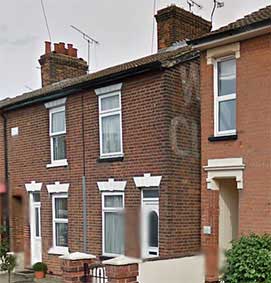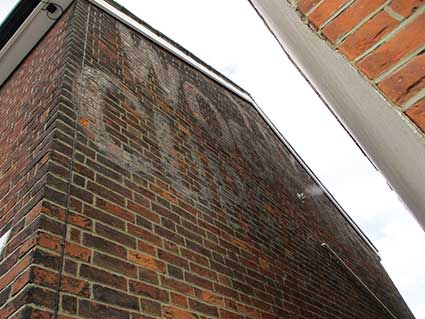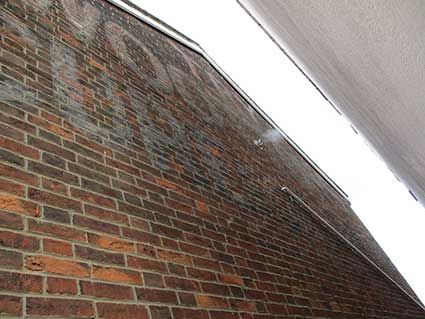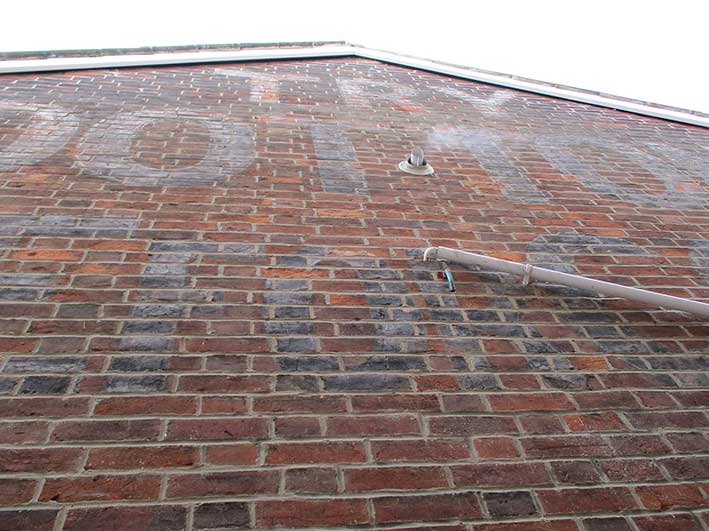The slightly smaller and central
'FOR' acts as a fulcrum for 'CURE' and 'CORNS' to really emphasise the
function of the product – presumably an ointment with which to annoint
those painful podiatric excrescences. The somewhat pleading 'TRY'
suggests that this was a new preparation when the sign was painted. For
a note about 'Woottons' see point 5 below.
Clearly the sign was a
considerable eye-catcher for those walking northwards up the
residential street that is Camden Road towards Foxhall Chippy and the
Foxhall Road junction with The Heathlands public house (formerly The
Asylum Hotel – as shown on our California page – and now a small
supermarket) across the road. However, this advertisement poses all
sorts of questions:-
- 1. Why site this sign on a small, quiet, residential road and not on Foxhall Road where it would be seen by far more people?
- 2. Do the residents of Camden Road suffer more from corns on their feet than others in Ipswich?
- 3. Why are the characters so big? Camden Road runs south for a about half a mile from Foxhall Road to be truncated by the Ipswich to Felixstowe railway line, turning left into the short Exeter Road, then northwards again up Dover Road. It therefore isn't a road which a great many passers-by would use and, in doing so, would read the sign.
- 4. How long was the sign visible before the next-door detached house was built, obscuring the sign from view? The plaque on the terrace reads:
‘CLENYU
COTTAGES
1882[?]’
COTTAGES
1882[?]’
so the advertisement was painted
after that date, presumably with a payment to the residents from
Woottons – or was the first resident Mr Wootton himself? The
residential developments during the Victorian and Edwardian
periods tended to be rather piecemeal in nature; houses or groups of
houses, being erected by different landowners/builders at different
dates. Infilling of plots followed and this is probably what happened
to the sign in Camden Road.
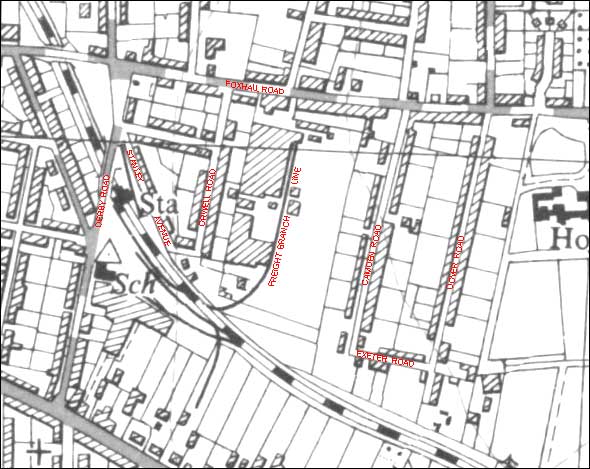
Wootton's Remarkable Cure For Corns
[UPDATE 20.4.2021: 'Just read your interesting article on Wootton’s the hair salon and I notice the below question was asked re. The Cure for Corns and whether there was a link. The below pot lid confirms it was retailed by Wootton’s. Simon Dyer.'] Many thanks to Simon for sending this fascinating piece of cross-fertilising promotion on a ceramic pot lid. Not only the extensive extolling of the virtues of their Macassar Pomade: "will effectually remove dandriff (sic)", but also, around the perimiter:
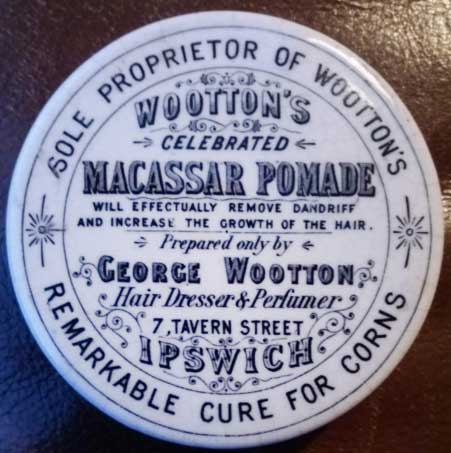 Image
courtesy Simon Dyer
Image
courtesy Simon Dyer
Note also the nearby lost trade sign painted on the side wall of a house on the corner of Foxhall Road and Orwell Road.
Home
Please email any comments and contributions by clicking here.
Search Ipswich
Historic Lettering
©2004 Copyright throughout the Ipswich Historic Lettering site: Borin Van Loon
No reproduction of text or images without express written permission
- 5. We wonder if there is any relation to Woottons (it's the same spelling) in Tavern Street? The shop was once Woottons
hair-dressers but, judging by the readable lettering above the old
shop, it dealt in products and services revolving around the body.
Perhaps they produced their own patent medicines, including a cure for
corns

Wootton's Remarkable Cure For Corns
[UPDATE 20.4.2021: 'Just read your interesting article on Wootton’s the hair salon and I notice the below question was asked re. The Cure for Corns and whether there was a link. The below pot lid confirms it was retailed by Wootton’s. Simon Dyer.'] Many thanks to Simon for sending this fascinating piece of cross-fertilising promotion on a ceramic pot lid. Not only the extensive extolling of the virtues of their Macassar Pomade: "will effectually remove dandriff (sic)", but also, around the perimiter:
'SOLE PROPRIETOR OF
WOOTTON'S REMARKABLE CURE FOR CORNS'
 Image
courtesy Simon Dyer
Image
courtesy Simon DyerNote also the nearby lost trade sign painted on the side wall of a house on the corner of Foxhall Road and Orwell Road.
©2004 Copyright throughout the Ipswich Historic Lettering site: Borin Van Loon
No reproduction of text or images without express written permission
